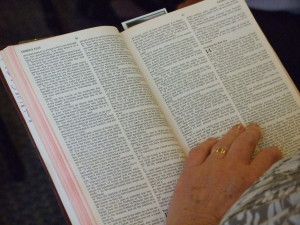 I’ve encountered a number of people who have concerns that the translations of the Bible that are available today can hardly be expressing what was intended by the original authors. They explain that text that was written in Aramaic then translated to Greek, which was then translated to German, which was then translated to English of the King James era, and then finally translated to modern English, has gone through so many revisions that it can’t be accurate.
I’ve encountered a number of people who have concerns that the translations of the Bible that are available today can hardly be expressing what was intended by the original authors. They explain that text that was written in Aramaic then translated to Greek, which was then translated to German, which was then translated to English of the King James era, and then finally translated to modern English, has gone through so many revisions that it can’t be accurate.
 This scenario brings to mind the party game where one person tells a story and it is passed down a line as best as it can be remembered by each individual without the use of notes. The story that reaches the final person in the line often barely resembles the story told by the first person!
This scenario brings to mind the party game where one person tells a story and it is passed down a line as best as it can be remembered by each individual without the use of notes. The story that reaches the final person in the line often barely resembles the story told by the first person!
While that is a humorous metaphor, let’s consider how well it parallels Bible translation to see if it is relevant.
The people in the party game were not to take any notes. All of the translations of the Bible we are considering are written texts that can be referred to even today.
The people in the party game often know that the fun in playing the game is all about how convoluted the story becomes. They are at a party and trying to have a good time, so they are not especially interested in preserving every detail of the story. Contrast this attitude to the attitude of monks who would destroy a page and begin copying it all over again if they made a single error.
 Also, those who translated from one language to another were not merely students in a language class who were given homework to translate a story. Such a student may choose to avoid putting in much effort. Their story translations might suffer and be somewhat sloppy. For instance a “blazing inferno” in the original text might be reduced to a “fire” in the translation. Those who translated the Bible knew they were bringing the Bible to a large group of people who would have no other written versions of it available to them. It is reasonable to believe that as people of faith they were committed to accurately bringing the Word of God to those who otherwise wouldn’t have it. It was not a hobby or a chore to them, but more likely considered a divine calling on their lives. Returning to our party game comparison, the translators of the Bible were far more interested in getting the message right than the people in the party game.
Also, those who translated from one language to another were not merely students in a language class who were given homework to translate a story. Such a student may choose to avoid putting in much effort. Their story translations might suffer and be somewhat sloppy. For instance a “blazing inferno” in the original text might be reduced to a “fire” in the translation. Those who translated the Bible knew they were bringing the Bible to a large group of people who would have no other written versions of it available to them. It is reasonable to believe that as people of faith they were committed to accurately bringing the Word of God to those who otherwise wouldn’t have it. It was not a hobby or a chore to them, but more likely considered a divine calling on their lives. Returning to our party game comparison, the translators of the Bible were far more interested in getting the message right than the people in the party game.
Additionally, a crucial difference between the party game and Bible translation hinges on the concept that each translation came from the previous translation. Is that truly the way the current translations came about? The answer is a resounding “NO!” Those who translate the Bible go back to the earliest recognized versions of the Bible and translate directly from those versions.
Let’s examine the way that New Living Translation of the Bible came to be. Regarding the text input, the following documents were used as base texts for the Old Testament:
- Masoretic Text of the Hebrew Bible
- Dead Sea Scrolls
- Septuagint
- Other Greek documents
- Samaritan Pentateuch
- Syriac Peshitta (in Aramaic)
- Latin Vulgate
- Other versions that clarified the meaning of difficult sections
The New Testament was based on the two standard editions of the Greek New Testament since it has long been accepted that the New Testament was originally written in Greek. Recently evidence has shown that the New Testament was actually written in Aramaic originally, and then translated into Greek.
 Next, let’s examine who was responsible for translating these documents into the New Living Translation. A team of qualified scholars of the Bible was assembled. They represented an array of different Evangelical perspectives. Added to that team were skilled English stylists who would assist in shaping the text to make it clear and easily read.
Next, let’s examine who was responsible for translating these documents into the New Living Translation. A team of qualified scholars of the Bible was assembled. They represented an array of different Evangelical perspectives. Added to that team were skilled English stylists who would assist in shaping the text to make it clear and easily read.
Each book of the Bible was assigned to three scholars who specialized in that book. They each worked independently, reviewing the base documents and noting suggested changes to make the text more understandable to today’s readers. Their suggestions were submitted to a senior translator who considered each of the scholars’ input and compiled a rough draft.
 Next the rough draft went through several rounds of review for interpretation. And style of wording. Once those reviews were complete the Bible Translation Committee got together and reviewed and approved every verse. After that the Senior Translator and Bible scholars verified that the meaning had not been altered.
Next the rough draft went through several rounds of review for interpretation. And style of wording. Once those reviews were complete the Bible Translation Committee got together and reviewed and approved every verse. After that the Senior Translator and Bible scholars verified that the meaning had not been altered.
Wow! What an undertaking! Certainly great care was taken to accurately translate from, and to keep referring to, the best source documents to avoid the party game effect.
You may be wondering why then are there so many English translations. After all, English is English, right? If every translation were done properly shouldn’t they all come out the same? Well, not really. There are different types of translations:
- the more formal, word for word, style
- the thought for thought style
Neither is right, nor wrong. They just serve different purposes. Though you might first choose a word for word type of translation to be able to get to the “real message” more quickly, you’d likely find it awkward to read and understand. Why? Because if you aren’t a Biblical scholar or one who studies ancient documents professionally, you’re likely to have difficulty understanding
- metaphors from ancient times
- idioms that are from those days
- syntax of the time
- money values
- measurements that are referred to
- references to time of day or year
This is exactly why the thought for thought style of translation exists. Scholars who do understand those more difficult passages want to make it easy for the average person to understand their meaning. An example from Proverbs 26:27 may help clarify this point:
Word for Word Style of Translation:
“He who digs a pit will fall into it, and he who rolls a stone, it will come back on him.”
At first glance this Proverb looks as if it is discussing a bumbling quarry worker who stumbles into the hole he just dug, or gets his toes caught under a rock he just moved. You may well be thinking “How odd! And this made it into the Bible to be taught to generation upon generation of Jewish and Christian people. Are you kidding?”
No, that’s not what the Proverb is really about. Take a look at another translation of the same verse:
Thought for Thought Style of Translation:
“If you set a trap for others, you will get caught in it yourself. If you roll a boulder down on others, it will crush you instead.”
Now you can see that the Proverb is not talking about what a bumbling quarry worker is doing, but about a principle of living. That is more likely to be something that generations of Jewish and Christian people would want to teach their children. So it makes a lot more sense to find it in the Bible.
Even though the second translation is not the same, word for word, as the first translation, it is now understandable as a concept. That is the goal of thought for thought translation.
 Other goals may be considered when translating, and again these are neither right, nor wrong, but just different perspectives. For example “The Message” is a Bible translation that is meant to bring what seems like ancient history into modern times. The author takes the viewpoint that what is recorded in the Bible was written in common, everyday language of the time. So he translated it into modern everyday language, using modern idioms.
Other goals may be considered when translating, and again these are neither right, nor wrong, but just different perspectives. For example “The Message” is a Bible translation that is meant to bring what seems like ancient history into modern times. The author takes the viewpoint that what is recorded in the Bible was written in common, everyday language of the time. So he translated it into modern everyday language, using modern idioms.
 In contrast, the translators of the New Living Translation made an effort to avoid idioms. Instead they chose wording that they felt would continue to make sense for many years to come. They also chose to explain rather than use terms that have been used in churches for hundreds of years, so that someone who is not familiar with “church speak” can easily understand the text. For example, instead of using the term “justified” they used the phrase “we are made right with God.” Instead of the term “sanctified” they wrote “we are made holy,” and so forth.
In contrast, the translators of the New Living Translation made an effort to avoid idioms. Instead they chose wording that they felt would continue to make sense for many years to come. They also chose to explain rather than use terms that have been used in churches for hundreds of years, so that someone who is not familiar with “church speak” can easily understand the text. For example, instead of using the term “justified” they used the phrase “we are made right with God.” Instead of the term “sanctified” they wrote “we are made holy,” and so forth.
Many different versions of the Bible are available so that you can choose the ones that appeal most to you. Why would you choose to use more than one translation? You can get a much clearer understanding of a passage that isn’t completely clear to you if you read the same passage in multiple translations. When I don’t quite get a passage I’ll usually look it up in four different translations. Often the meaning of the passage will then be clear to me. If I’m still in doubt about it, then I’ll discuss it with others to learn how they interpret it.
Happy reading!